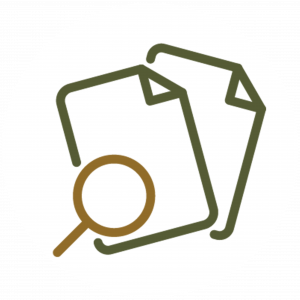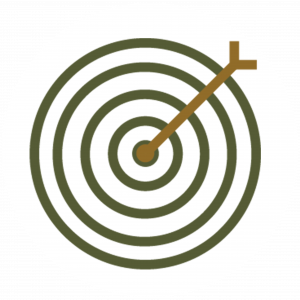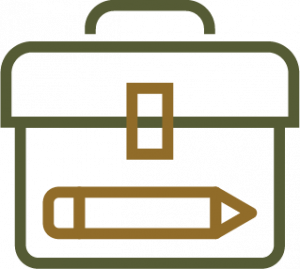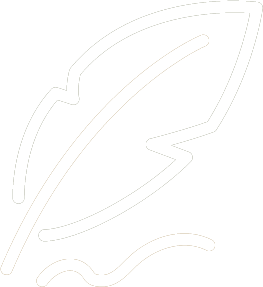Week 18: Ways to Communicate with Technology
LOC 18: Extend how to use a variety of digital literacies as a communication tool for their students who have limited skills or limited access to technology
Learning Objectives
By the end of this week, participants will be able to:
- 18.1 – Produce a variety of templates that demonstrate a step-by-step method
- 18.2 – Illustrate and use proper etiquette when communicating
Materials Needed This Week
Here is a list of materials you will need while completing this week:
- Writing utensils
- Highlighters
- Ruler
- Sticky Notes
- Dictionary/Glossary booklet
- Handwritten Wisdom Journal

- Blank paper
- Computer/laptop
Key Terms
Add these key terms to your personal dictionary/glossary booklet. These important key terms will be used throughout module 4, week 18. If there is no link attached to the definition, be assured that the term will be defined throughout the week. We encourage you to further investigate the definitions in order to expand your knowledge.
- Text
- PowerPoint
- Social media
- Netiquette
 Questions to Consider
Questions to Consider
1. Why is choosing the right technology for communicating so important?
2. Why are there netiquette rules to professional communication?
3. How important is it to know and apply the netiquette rules?

“It is not about the technology; it’s about sharing knowledge and information, communicating efficiently, building learning communities and creating a culture of professionalism in schools. These are the key responsibilities of all educational leaders.” — Marion Ginapolis
 Review
Review
Consult the following resource and interpret the necessary information with your preferred method of note-taking.
What is Digital Technology? 25 Best Examples (article)
 Identify
Identify
Consult the following resource below to locate the important information on this week’s topic.
Click the first link on the ABC Life Literacy Canada website to open up a PDF workbook called the ABC Internet Matters workbook 2020.
ABC Internet Matters workbook (2020) (website)
 Develop
Develop
Video: “Netiquette: A Student’s Guide to Digital Etiquette” (1:51)
Click here for a video transcript in .docx format: Video Transcript
- Be brief. Your message should not be longer than one screen or about 300 words. Each message should have one basic point that others can respond to.
- If you must post a longer message, break it into two pieces that you post separately. Also include a descriptive title, an abstract for people to determine if they wish to read the whole entry, and several paragraph breaks for readability.
- It is recommended that you always compose longer messages in a word document. This serves two purposes; you do not risk losing your comments through some malfunction of the board which happens frequently. It also gives you time to think about your wording, tone, and overall message.
- Do not use capital letters for whole words as this conveys that you are “shouting.”
- Use each other’s names, thank each other, affirm each other, and acknowledge your colleagues’ contributions to your learning.
- If you wish to critique a person’s posting, demonstrate active listening by paraphrasing what a participant has said first, before responding with your critique.
- Be gentle with criticism — it can come across as very cutting or sarcastic in an online setting. Try drafting a message first, letting it sit, and then reviewing it before you post it. You may also ask your course professor to review your message before posting.
- Respond promptly to any messages received. If you do not have time for a reply immediately, let your classmate know that you will get back to them soon. If you will be out of computer contact for more than a day, let the class and your course professor know.
View the following resource to learn how to present and create better presentations.
The Learning Portal Digital Skills: Presentations (tutorial)
 Apply
Apply
Task
Here are some in-class strategies for you to try:
- Take the whole class to the library to learn about accessing electronic resources and lookup library items using the Internet.
- Collect students’ email addresses and photocopy the list for everyone (with their permission) and allow students to communicate with each other via email.
- Experiment with PowerPoint as a way of organizing material and highlighting points of interest of digital skills. Form groups amongst your students, assign each communication tool, and have them use PowerPoint in order to present information to the whole class in their own step-by-step process.
 Take Away Toolbox
Take Away Toolbox
- Microsoft PowerPoint help & learning (website)
 Reflect
Reflect
 Handwritten Wisdom Journal
Handwritten Wisdom Journal
A Wisdom Writing Journal is a way to notarize your learning journey throughout the weeks during all the modules in this course. It will also permit you to demonstrate that no technology is required to focus on reflective practice. There is a variety of writing journal tools that you can choose from that require technology, however, throughout this course, it is important that you experience and model a no-technology required method in order to relate to those students that have limited or no access to technology.
Take advantage of jotting down your thoughts, frustrations, joys, aha moments, and new information acquired as the result of your hard work. Critical reflection time required at the end of each week will be a culminating result of YOUR own personal Learning Narrative.
Using your own personal writing journal, write an entry for this week’s prompts:
- Why is it important to be flexible with communication tools especially for adult students who have no access to technology or have low skills when using technology?
- How can you support your students while still communicating with them?
- How does it make you feel when your students are reiterating step-by-step information back to their adult peers?
- Based on the information that you have learned this week, how would you review, identify, develop, apply, and reflect?
Note: Be sure to justify each of your answers or comments.
Optional Resources
These resources are not required to be viewed; however, they give further information on this week’s topics:

